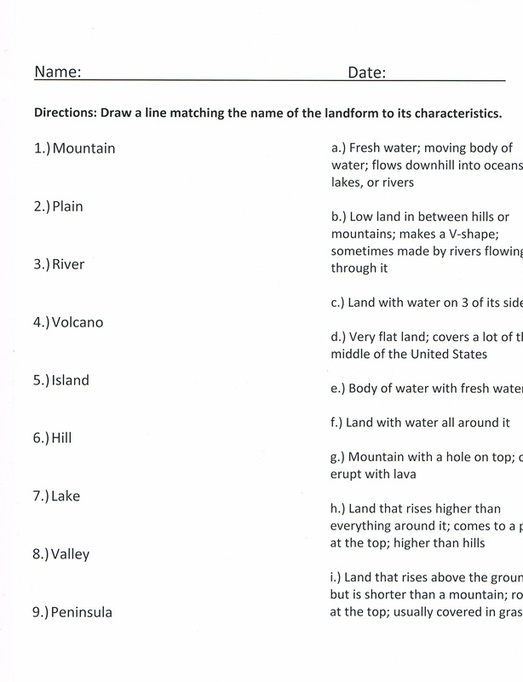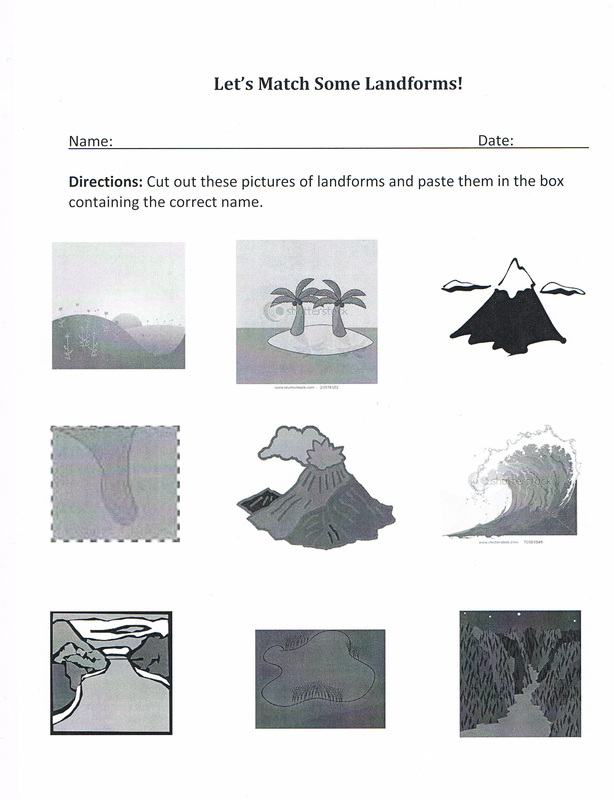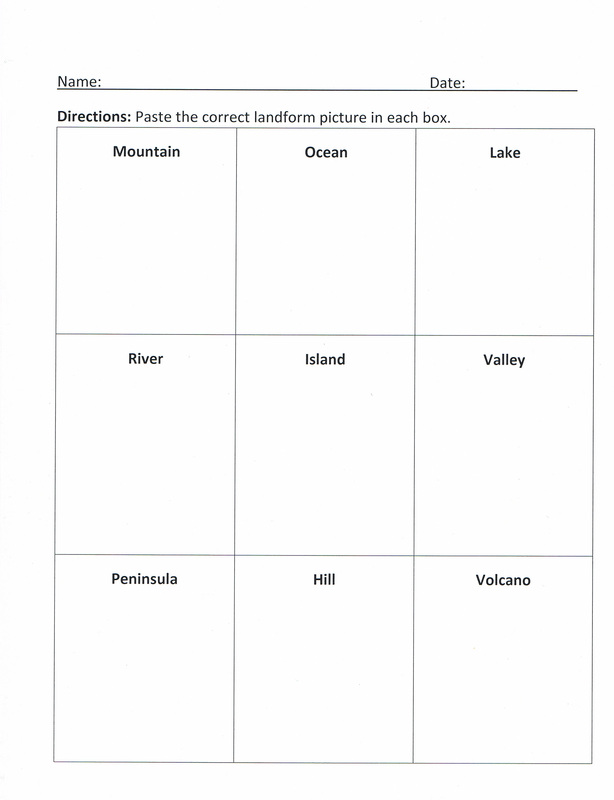
Topic: The topic of this lesson will be landforms. Since the class has already had a previous lesson on the subject, this one will be more in-depth and focus on more specific details of individual landforms via expert groups.
Rationale: Experts groups are a great way to get students to delve deeper into a subject and find out more than just their general information. It would be unreasonable to expect every student to become an expert on every landform we learn about; however, with this lesson it allows all of the students to become “experts” on at least one of the landforms we go over. This way, they have a general understanding of all landforms and can identify them, but there is one landform in particular that they can gain a lot more knowledge on and realize that the subject can go much further than just what the landform looks like. This is true for all subjects. It can be very difficult for teachers to decide how far into a topic they want to go and how far they can go based on time constraints, supplies, and the abilities of the students. This lesson allows some in-depth work without taking away from students’ properly learning about other parts of the topic or sacrificing any other learning. It also allows students to collaborate and share interesting information with each other.
Prior Knowledge: Before this lesson, students will need to know the various names of specific landforms and general information on each of them including what it is, what it looks like, the name for it, etc. Some misconceptions students may have could include thinking that landforms were just always a part of earth and they will always be here and stay the same. They may not realize that the earth is changing and some landforms are forming, like new rivers and valleys, while others are going away. They also may not believe that a landform can also be a habitat and that others live within landforms. For example, bodies of water are the homes for many different kinds of animals, especially fish. The students’ imaginations will be captured by this lesson with the many supplies and techniques they will be provided with for their expert groups. They will be able to do research online, read books, draw pictures, etc. so that each student will really feel like they are getting to know their landform well. They will be seeing their assigned landform as more than just a piece of the earth; they will know about the animals that live there, how they were made, etc. and this will help them to feel like they are almost a part of the landform and imagine themselves being very close with it and knowing all about it. The landform is almost like a character from a story that the students are getting to know and imagining in their heads.
NJ Standards:
6.6.B.1 Describe the physical features of places and regions on a simple scale.
6.6.B.2 Describe the physical and human characteristics of places.
Objectives
Students will become “experts” on their assigned landform.
Assessments
Students will make presentations to the class on their assigned landforms.
Hook: For the hook of our lesson, I will model for the class what the expert groups should be doing and what their presentations should look like. I will pick one of the other landforms we went over that was not assigned to a group and do all the jobs/parts in the expert group. I will show them an illustration, do some research on famous examples of our landform, find out about who lives in or near our landform, etc. and present this to the class. This way, the students will have a better idea of what they should be doing because we are modeling it for them.
Activities, Questions, Examples, and Groups: To begin the lesson, we will bring the students down to the carpet. We will call them down based on who is sitting quietly and ready. The students will be reminded of their groups and topics from yesterday. Once everyone is settled on the carpet, we will do our hook and then review what is expected of them for the expert group. We will hand out the materials. Then the students will break into their groups and work on each of their jobs in the group. We will go around making sure each member of the group is doing the proper work for their job. See job descriptions in attachment below. We will allow the students time to finish up tomorrow and then the students will do their mini presentations tomorrow.
Closure: For the closure of this lesson, the students will complete a worksheet. The students will be given one sheet with sketches of each of the landforms they have learned about. They will cut out all of the pictures. On another worksheet will be the names of the various landforms and a space for the students to glue the pictures they cut out from the other sheet. This will serve as a quick assessment for us to see if they can correctly identify landforms based on their pictures.
Materials: a computer with internet access, books on specific landforms, landform closure worksheet, blank paper, scissors, glue, crayons and markers
Individualization: This lesson provides a lot of room for individualization. To start, we explain how the expert groups work for the auditory learners who learn by hearing lectures or explanations from teachers, we have a worksheet explaining the jobs of the expert group for students who like to be able to read and comprehend at their own pace and like to go back and reread instructions, and we are even modeling the expert groups during our hook so that our visual learners and our learners who learn things by seeing them will be able to easily comprehend the lesson. Within the actual expert groups, every student will have a different job so they can work on a part of the group that is conducive to the way they learn. For example, a student that is a visual learner can do the illustration job and students that are not visual learners do not have to worry about learning about their landform in this way. Students who like writing things down in order to learn them can be the researchers and copy information from the websites we provide them to look up information on their landform. Students who enjoy reading to learn can be the readers in the expert group who read books that deal with their landform. There are many opportunities within this lesson for individualization.
Follow-Up Activities: Students will get additional time to work with their expert groups tomorrow. Future lessons should review what was learned about them such as their names and characteristics that identify each landform. Future lessons should also have students notice landforms that surround them and are in their area. This should allow the students to apply what they have learned about what landforms are.
Rationale: Experts groups are a great way to get students to delve deeper into a subject and find out more than just their general information. It would be unreasonable to expect every student to become an expert on every landform we learn about; however, with this lesson it allows all of the students to become “experts” on at least one of the landforms we go over. This way, they have a general understanding of all landforms and can identify them, but there is one landform in particular that they can gain a lot more knowledge on and realize that the subject can go much further than just what the landform looks like. This is true for all subjects. It can be very difficult for teachers to decide how far into a topic they want to go and how far they can go based on time constraints, supplies, and the abilities of the students. This lesson allows some in-depth work without taking away from students’ properly learning about other parts of the topic or sacrificing any other learning. It also allows students to collaborate and share interesting information with each other.
Prior Knowledge: Before this lesson, students will need to know the various names of specific landforms and general information on each of them including what it is, what it looks like, the name for it, etc. Some misconceptions students may have could include thinking that landforms were just always a part of earth and they will always be here and stay the same. They may not realize that the earth is changing and some landforms are forming, like new rivers and valleys, while others are going away. They also may not believe that a landform can also be a habitat and that others live within landforms. For example, bodies of water are the homes for many different kinds of animals, especially fish. The students’ imaginations will be captured by this lesson with the many supplies and techniques they will be provided with for their expert groups. They will be able to do research online, read books, draw pictures, etc. so that each student will really feel like they are getting to know their landform well. They will be seeing their assigned landform as more than just a piece of the earth; they will know about the animals that live there, how they were made, etc. and this will help them to feel like they are almost a part of the landform and imagine themselves being very close with it and knowing all about it. The landform is almost like a character from a story that the students are getting to know and imagining in their heads.
NJ Standards:
6.6.B.1 Describe the physical features of places and regions on a simple scale.
6.6.B.2 Describe the physical and human characteristics of places.
Objectives
Students will become “experts” on their assigned landform.
Assessments
Students will make presentations to the class on their assigned landforms.
Hook: For the hook of our lesson, I will model for the class what the expert groups should be doing and what their presentations should look like. I will pick one of the other landforms we went over that was not assigned to a group and do all the jobs/parts in the expert group. I will show them an illustration, do some research on famous examples of our landform, find out about who lives in or near our landform, etc. and present this to the class. This way, the students will have a better idea of what they should be doing because we are modeling it for them.
Activities, Questions, Examples, and Groups: To begin the lesson, we will bring the students down to the carpet. We will call them down based on who is sitting quietly and ready. The students will be reminded of their groups and topics from yesterday. Once everyone is settled on the carpet, we will do our hook and then review what is expected of them for the expert group. We will hand out the materials. Then the students will break into their groups and work on each of their jobs in the group. We will go around making sure each member of the group is doing the proper work for their job. See job descriptions in attachment below. We will allow the students time to finish up tomorrow and then the students will do their mini presentations tomorrow.
Closure: For the closure of this lesson, the students will complete a worksheet. The students will be given one sheet with sketches of each of the landforms they have learned about. They will cut out all of the pictures. On another worksheet will be the names of the various landforms and a space for the students to glue the pictures they cut out from the other sheet. This will serve as a quick assessment for us to see if they can correctly identify landforms based on their pictures.
Materials: a computer with internet access, books on specific landforms, landform closure worksheet, blank paper, scissors, glue, crayons and markers
Individualization: This lesson provides a lot of room for individualization. To start, we explain how the expert groups work for the auditory learners who learn by hearing lectures or explanations from teachers, we have a worksheet explaining the jobs of the expert group for students who like to be able to read and comprehend at their own pace and like to go back and reread instructions, and we are even modeling the expert groups during our hook so that our visual learners and our learners who learn things by seeing them will be able to easily comprehend the lesson. Within the actual expert groups, every student will have a different job so they can work on a part of the group that is conducive to the way they learn. For example, a student that is a visual learner can do the illustration job and students that are not visual learners do not have to worry about learning about their landform in this way. Students who like writing things down in order to learn them can be the researchers and copy information from the websites we provide them to look up information on their landform. Students who enjoy reading to learn can be the readers in the expert group who read books that deal with their landform. There are many opportunities within this lesson for individualization.
Follow-Up Activities: Students will get additional time to work with their expert groups tomorrow. Future lessons should review what was learned about them such as their names and characteristics that identify each landform. Future lessons should also have students notice landforms that surround them and are in their area. This should allow the students to apply what they have learned about what landforms are.
Resources:
Click here: About the Expert Groups



